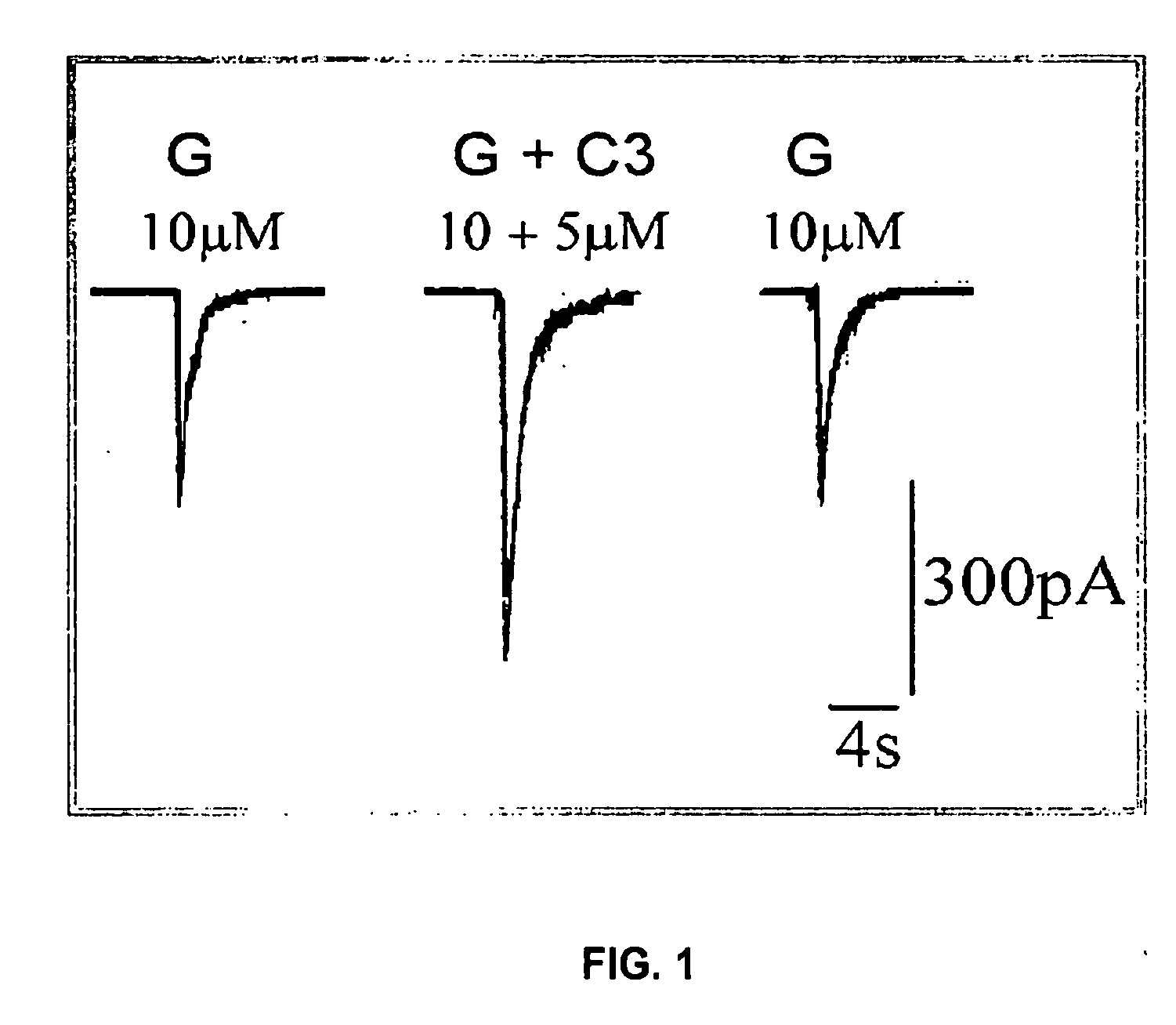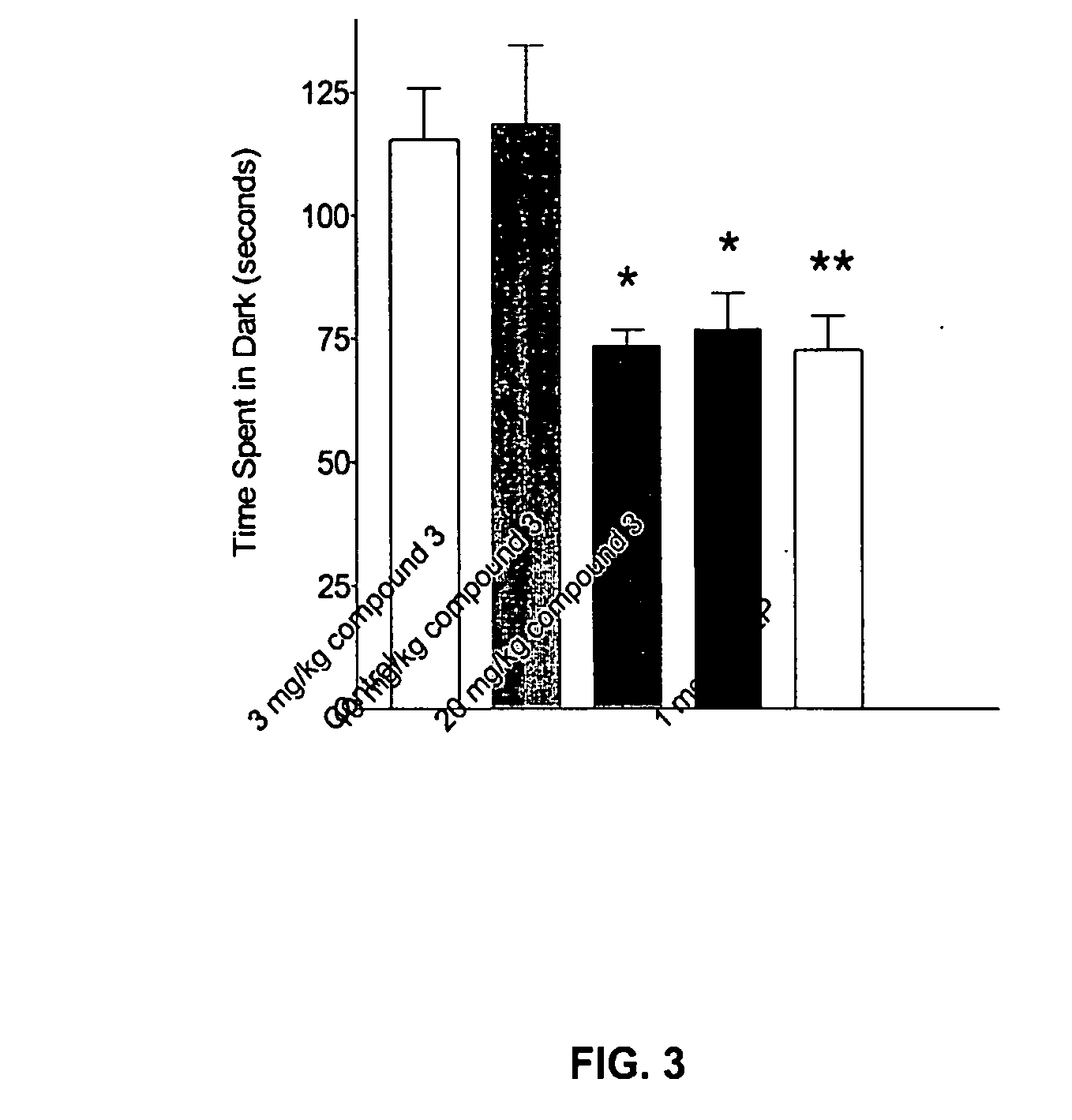Substituted quinolone carboxylic acids, their derivatives, site of action, and uses thereof
- Summary
- Abstract
- Description
- Claims
- Application Information
AI Technical Summary
Benefits of technology
Problems solved by technology
Method used
Image
Examples
example 1
7-Chloro-1-ethyl-6-(1,2,3,4-tetralydronaphtlyl-1-amino)-4-oxo-1,4-dilydroquinoline-3-carboxylic acid
[0084] To a suspension of 7-chloro-1-ethyl-6-fluoro-4-oxo-1,4-dihydroquinoline-3-carboxylic acid (Acros; 6.02 g, 22.3 mmol) in 30 mL of 1-methyl-2-pyrrolidinone was added neat 1,2,3,4-tetrahydro-1-aminonaphthalene (20 mL, 20.5 g, 140 mmol) drop-wise via syringe. The resulting light yellow mixture was placed in an oil bath at 140° C. for 17 h. Once at rt, the reaction was added to 120 mL of an aq. 2N HCl solution and ice. The solid that formed was isolated by filtration, washed with an aq. 2N HCl solution (120 mL), water (2×100 mL), MeOH (3×50 mL) and EtOAc (50 mL). The solid that remained was then recrystallized from MeOH (1400 mL). The yellow needles that formed were isolated and washed with methanol (2×50 mL). This solid was then subjected to flash column chromatography. A solution of the solid in 35 mL of 4% MeOH / CH2Cl2 was added to 16 cm of silica in a 5 cm dia. column. Elution w...
example 2
7-Chloro-1-ethyl-6-(1,2,3,4-tetrahydronaphthyl-1-amino)-4-oxo-1,4-dihydroquinoline-3-(n-propyl)carboxamide
[0109] To a solution of 7-chloro-1-ethyl-6-(1,2,3,4-tetrahydronaphthyl-1-amino)-4-oxo-1,4-dihydroquinoline-3-carboxylic acid (37 mg, 0.093 mmol) in 5 mL of CHCl3 at −10° C. was added neat Et3N (30 μL, 22 mg, 0.22 mmol) and benzyl chloroformate (17 μL, 20 mg, 0.117 mmol). After stirring cold for 45 m, neat propylamine (10 μL, 7.2 mg, 0.122 mmol) was added via syringe to the reaction at −20° C. The reaction was then allowed to warm to rt over 2 h and added to 7 mL each of a 10% aq. K2CO3 solution and CHCl3. The organic layer was separated and washed with water (2×10 mL), dried (Na2SO4), filtered and concentrated to dryness. The residue was taken up in CH2Cl2 and added to 10 cm of flash silica gel in a 2 cm dia. column. Elution with 100% CH2Cl2 (100 mL) and 2.5% MeOH / CH2Cl2 (200 mL) gave 37 mg (91%) of the title compound as a yellow solid.
[0110] The following compounds were prepa...
example 3
7-Chloro-]-(2-phenethyl)-6-(1,2,3,4-tetrahydronaphthyl-1-amino)-4-oxo-1,4-dihydroquinoline-3-carboxylic acid
[0114] a. Ethyl 2-(2,4-dichloro-5-fluorobenzoyl)-3-(dimethylamino)acrylate. A mixture of ethyl 3,3-dimethylaminoacrylate (3.10 g, 21.6 mmol) and N,N-diisopropylethylamine (8.0 mL, 5.94 g, 45.9 mmol) was stirred at rt and a solution of 2,4-dichloro-5-fluorobenzoyl chloride (4.92 g, 21.6 mmol) was added drop-wise via addition funnel over 20 m. The cloudy yellow solution that formed was placed in an oil bath at 85-90° C. After 3 h, the mixture that formed was filtered and the solid was washed with benzene. The dark filtrate was concentrated and the residue was triturated with hexanes (50 mL). The solid that didn't dissolve was collected and washed with hexanes (20 mL). The resulting solid was partitioned between water and EtOAc. The EtOAc layer was washed with water (3×25 mL), brine, dried (Na2SO4), filtered and concentrated to 5.0 g (69%) of the desired compound.
[0115] b. Ethy...
PUM
| Property | Measurement | Unit |
|---|---|---|
| Molar density | aaaaa | aaaaa |
| Inhibition | aaaaa | aaaaa |
| Inhibition | aaaaa | aaaaa |
Abstract
Description
Claims
Application Information
 Login to View More
Login to View More - R&D
- Intellectual Property
- Life Sciences
- Materials
- Tech Scout
- Unparalleled Data Quality
- Higher Quality Content
- 60% Fewer Hallucinations
Browse by: Latest US Patents, China's latest patents, Technical Efficacy Thesaurus, Application Domain, Technology Topic, Popular Technical Reports.
© 2025 PatSnap. All rights reserved.Legal|Privacy policy|Modern Slavery Act Transparency Statement|Sitemap|About US| Contact US: help@patsnap.com



